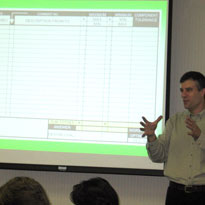DWDM – Advanced
- Course:DWDM – Advanced
- Course ID:DWDM Duration:2-3 days Where: Your Office (7+ Persons)
- Download Course Description (PDF)
Available as a private, customized course for your group at your offices or ours and in some cases as a WebLive(TM) class.
Course Outline
- Introduction
- Advantages and disadvantages of optical transmission
- History of optical transmission
- Wave Propagation through Fibers: Linear Regime
- Types of fiber
- Attenuation and dispersion
- More on Wave Propagation through Fibers: Non-Linear Regimes
- Chromatic dispersion
- Polarization mode dispersion
- Pulse dispersion
- Effective length/area
- Brillouiin/Raman scattering
- Four-wave mixing
- Self-/Cross-Phase Modulation (SPM/XPM)
- Passive Transmission Devices
- Couplers
- Splitters
- Isolators
- Circulators
- Gratings
- More on Passive Transmission Devices
- Fabry-Perot filter (FSR, Finesse)
- Mach-Zehnder interferometers
- Arrayed Waveguide Gratings (AWGs)
- Multiplexer architecture
- Active Transmission Devices
- Erbium-doped and Raman fiber amplifiers
- Semiconductor Optical Amplifiers (SOAs).
- Transmitters: Lasers, distributed-feedback lasers, mode-locked lasers
- LEDs
- More on Active Transmission Devices
- Direct and external modulation
- Detectors: Photodetectors and photodiodes
- Optical switches
- Wavelength converters
- Modulation
- Signal formats
- Subcarrier modulation
- Optical channel capacity
- Demodulation: Shot/thermal noise; ideal signal detection
- Optical signal-to-noise, bit error rate
- Intersymbol Interference (ISI)
- Coherent detection
- Point-to-Point Links
- Optical link budgets, margin
- Power penalties, maximum transmit power
- Dispersion compensation
- Amplifier cascades
- Client Layers
- SONET/SDH
- ATM
- IP
- DWDM Network Architecture
- Optical Add-Drop Multiplexers (OADMs)
- Optical Cross-Connects (OXCs)
- Lightpath Topology Design (LTD)
- Routing & Wavelength Assignment (RWA), Graph coloring
- More on DWDM Network Architecture
- Network survivability
- SONET rings
- Optical protection, reliability (MTBF, MTTR).
- Optical control and management
- Performance management, optical overhead.
- Optical Transport Network (OTN)
- Access Networks
- HFC
- FTTC
- Deployment Considerations
- ITU standards
- Undersea cable
- Emerging and Future DWDM Systems
- Photonic packet switching
- OTDM
- Wrap-up: Course Recap, Q/A, and Evaluations
Course in a Nutshell
Dense Wavelength Division Multiplexing (DWDM) is a key component of the world’s communications infrastructure. The tremendous growth in telecommunications services is possible today in part through optical networks, where DWDM systems allow much greater bandwidth over existing optical systems. For anyone involved with telecommunication and information technology, understanding this technology is a critical requirement.
In this course you will learn the technology, architecture, and applications of DWDM. We will review DWDM system components as well as the end-to-end optical network design process. You will also learn aspects of optical control, network management, and practical deployment issues such as optical submarine cable and access networks. This comprehensive review will provide all the knowledge and skills necessary to design and implement DWDM systems.
Customize It!
- Are you a transmission or network engineer who would like to “fill in the holes” and catch up with the state-of-the-art of optical systems? Let us know so we can focus on the areas that interest you the most.
- Are you an optical communications system installer who would like to learn the concepts and theory that underlie your craft? We can focus on the tools and techniques that will help you become more “tech savvy”.
- Are you a manager, executive, or sales person whose work involves optical communication systems? If so, we can emphasize those parts of the course that deal with the markets and applications pertinent to your project or product.
- Add a workshop day at the end of the course, for a total of three days: Get some hands-on practice on an optical simulation and modeling tool to help you with design, procurement, and installation of a DWDM system. We can help you get ready! Please ask us about the “combo discount”.
Learn How To
- Understand the conceptual and theoretical underpinnings of this field
- Describe how the DW/DM technology works
- Identify the applications of DWDM
- Explain the key components of DWDM systems
- Describe in detail the architecture of a DWDM network
- Design a DWDM system
- Describe the key considerations related to the deployment of DWDM
- Characterize the emerging and future DWDM systems
Aimed At
The standard presentation of this course assumes a bachelor of science in Electrical Engineering, Mathematics, Physics, or a related subject along with an appropriate background in communications.
Prerequisites
Some exposure to optical networking basics, such as may be gained from work experience or by taking our introductory DWDM course, is desirable.
- “Excellent presentation, content, knowledge of subject, sensitivity to marketing/sales issues, and respect for/listening to the audience. This is the best seminar that I have had in years, especially on the topic of networks. Bravo!” – J. Krieger, Sr. Software Engineer, Large US Secure Communications Manufacturer

